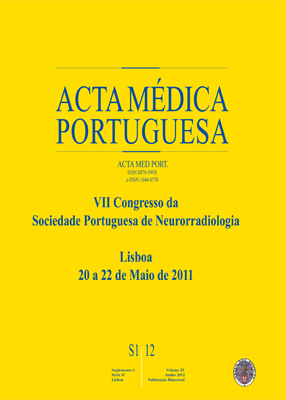Neuroimagem na Infecção Vírus da Imunodeficiência Humana
DOI:
https://doi.org/10.20344/amp.253Resumo
Introdução: A infecção do Sistema Nervoso Central (SNC) pelo Vírus da Imunodeficiência Humana (VIH) ocorre precocemente no curso da doença, estando associada a alterações que podem atingir qualquer nível do neuroeixo. A neuroimagem desempenha um papel cada vez mais importante, quer no diagnóstico, quer na monitorização longitudinal destas complicações, que podem ser divididas em três categorias principais: lesões associadas directamente ao VIH, infecções oportunistas e neoplasias.
Objectivos: Identificar e descrever as alterações neurorradiológicas encontradas numa população de doentes VIH positivos.
Métodos: Estudo retrospectivo, com análise dos processos clínicos e revisão dos estudos neuroimagiológicos de doentes VIH positivos internados no Centro Hospitalar de Coimbra - E.P.E. no período compreendido entre 1 de Janeiro de 2008 e 31 de Março de 2011.
Resultados: No período de estudo identificaram-se 337 episódios de internamento de doentes com infecção pelo VIH, correspondendo a um total de 196 pacientes. Destes, 88 foram submetidos a pelo menos um exame neuroimagiológico, apresentando uma idade média de 47,1 (27-89) anos, sendo que 75% eram do sexo masculino. Em 12,5% dos exames não se identificaram alterações de registo. Em 69,3% observou-se atrofia, em 31,2% a presença de lesões sequelares com etiologias diversas (vascular, infecciosa), tendo-se identificado oito casos de encefalite por VIH. Em 19,3% dos doentes diagnosticou-se a presença de infecção oportunista (11 casos de Toxoplasmose, quatro de Leucoencefalopatia Multifocal Progressiva, um de Tuberculose e um de Neurossífilis). Referem-se ainda 10 casos com evidências de lesões vasculares recentes. Embora, em alguns casos, consideradas no diagnóstico diferencial, na amostra deste estudo não se identificaram neoplasias.
Conclusões: O (re)conhecimento das alterações do SNC associadas à infecção por VIH e dos seus padrões imagiológicos é fulcral para o respectivo diagnóstico e estabelecimento de terapêutica adequada. As técnicas avançadas de Ressonância Magnética podem ter um papel importante neste contexto.
Downloads
Downloads
Publicado
Como Citar
Edição
Secção
Licença
Todos os artigos publicados na AMP são de acesso aberto e cumprem os requisitos das agências de financiamento ou instituições académicas. Relativamente à utilização por terceiros a AMP rege-se pelos termos da licença Creative Commons ‘Atribuição – Uso Não-Comercial – (CC-BY-NC)’.
É da responsabilidade do autor obter permissão para reproduzir figuras, tabelas, etc., de outras publicações. Após a aceitação de um artigo, os autores serão convidados a preencher uma “Declaração de Responsabilidade Autoral e Partilha de Direitos de Autor “(http://www.actamedicaportuguesa.com/info/AMP-NormasPublicacao.pdf) e a “Declaração de Potenciais Conflitos de Interesse” (http://www.icmje.org/conflicts-of-interest) do ICMJE. Será enviado um e-mail ao autor correspondente, confirmando a receção do manuscrito.
Após a publicação, os autores ficam autorizados a disponibilizar os seus artigos em repositórios das suas instituições de origem, desde que mencionem sempre onde foram publicados e de acordo com a licença Creative Commons









